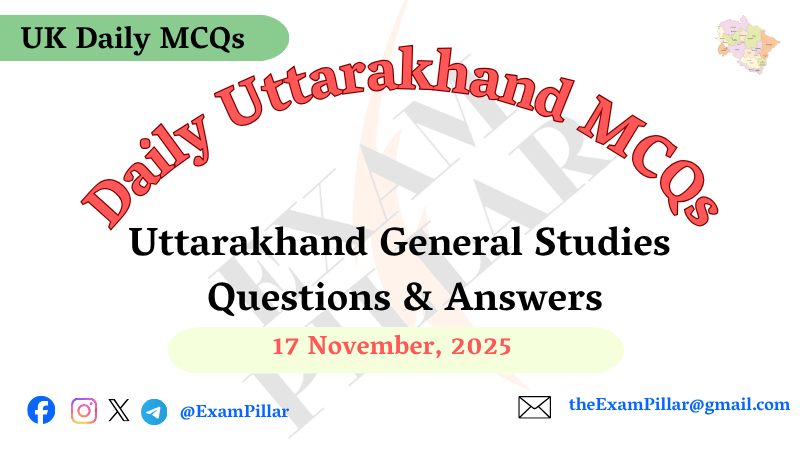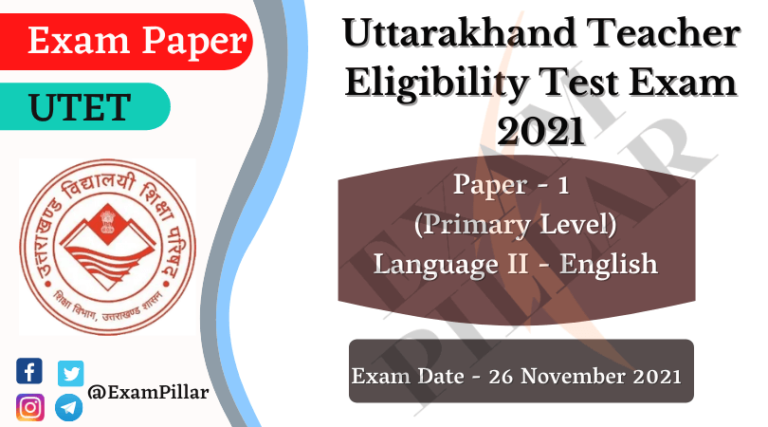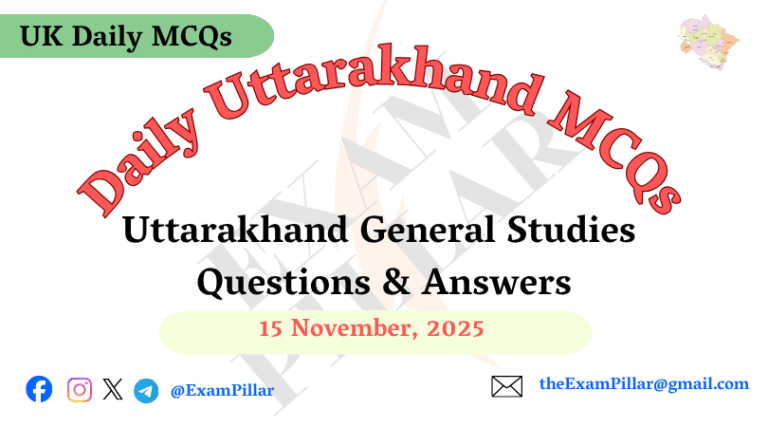The Exam Pillar brings you the Daily MCQs program for examinations conducted by the Uttarakhand Public Service Commission (UKPSC) and the Uttarakhand Subordinate Services Selection Commission (UKSSSC). This program provides candidates with objective study materials tailored to the exam format of the Uttarakhand Public Service Commission and the Uttarakhand Subordinate Services Selection Commission.
Daily UKPSC / UKSSSC MCQs : Uttarakhand
17 November, 2025
| Read This UKPSC / UKSSSC Daily MCQ – (Uttarakhand) in Hindi (हिन्दी) Language |
Q1. What type of rock paintings were found in Kimni village, and in which color were they painted?
(A) Weapon and animal figures, light white color
(B) Dance and human figures, red color
(C) War scenes, black color
(D) Agriculture and water sources, blue color
Click To Show Answer/Hide
Explanation: From Kimni village, rock paintings of weapons and animals painted in light white color have been found. These paintings reveal that people of that time depicted their hunting, security, and economic activities artistically. They also provide evidence of early social life and technological understanding.
Q2. In which year and by whom was the first survey of Malari village conducted?
(A) 1983 CE, B. M. Khanduri
(B) 1956 CE, Shiv Prasad Dabral
(C) 2001 CE, Garhwal University
(D) 1998 CE, M. P. Joshi
Click To Show Answer/Hide
Explanation: The first survey of Malari village was conducted in 1983 by B. M. Khanduri under the Garhwal University. This survey documented ancient human activities and burial sites, making it important for understanding the region’s historical background.
Q3. Malari village is located in which district?
(A) Almora
(B) Chamoli
(C) Uttarkashi
(D) Pithoragarh
Click To Show Answer/Hide
Explanation: Malari village is located in the Chamoli district, near the remote border regions adjacent to Tibet. Its geographical and natural setting makes it significant for archaeological studies and ancient human activity.
Q4. Which animal’s complete skeleton was found in Malari village, and what was its identified species?
(A) Himalayan rhinoceros, Vrishabh Jubu
(B) Himalayan bear, Joba
(C) Himalayan bull, Jubu (Joba)
(D) Himalayan deer, Jubu
Click To Show Answer/Hide
Explanation: The survey at Malari village uncovered a complete skeleton of a Himalayan bull, identified as Jubu (Joba). This skeleton provides insight into ancient livestock practices and environmental conditions of that time.
Q5. The clay pottery and golden mask recovered from Malari village resemble the craftsmanship of which region?
(A) Swat Valley, Pakistan
(B) Kashmir Valley
(C) Gujarat
(D) Rajasthan
Click To Show Answer/Hide
Explanation: The 5.2 kg golden mask and clay pottery found at Malari village resemble the craftsmanship of the Swat Valley in Pakistan. This suggests cultural and artistic contact between Uttarakhand and the Swat region in ancient times.





Leave a Reply